Makes and Models
Cop Cars Around The Globe
 A couple of days ago, the Dubai police force created a bit of a stir in the automotive world by managing to scoop the Guinness World Record for the fastest police car on the roads: a Bugatti Veyron. With a top speed of 407 km/h and a 0–100 time of 2.5 seconds. The acquisition and fitting of the Veyron as a police car is something of a PR exercise for the Dubai Police; however, it joins some of the other supercars driven by the police in this country, making the United Arab Emirates possibly the country where it’s most fun to be a cop. Others in the Dubai police fleet include a Aston Martin One-77, a Lamborghini Aventador LP 700-4, a Ferrari FF and the “humbler”(?) Audi R8 , Nissan GTR and Mercedes SL 63.
A couple of days ago, the Dubai police force created a bit of a stir in the automotive world by managing to scoop the Guinness World Record for the fastest police car on the roads: a Bugatti Veyron. With a top speed of 407 km/h and a 0–100 time of 2.5 seconds. The acquisition and fitting of the Veyron as a police car is something of a PR exercise for the Dubai Police; however, it joins some of the other supercars driven by the police in this country, making the United Arab Emirates possibly the country where it’s most fun to be a cop. Others in the Dubai police fleet include a Aston Martin One-77, a Lamborghini Aventador LP 700-4, a Ferrari FF and the “humbler”(?) Audi R8 , Nissan GTR and Mercedes SL 63.
Not many of the boys and girls in blue around the world are so lucky. Most of them have to put up with much more mundane machines, albeit with all the extras that cops get to play with, including the lights and sirens.
Australia:
The Ford/Holden rivalry extends to the police fleet, with Ford Falcons and Holden Commodores making up the bulk of the fleet in various incarnations for the past 30 years or so. Now, however, with the demise of Ford and Holden in Australia, taking these iconic marques with them, the cops are looking for new wheels that can do the business of high-speed chases. The Kia Sorento SUV is one contender, along with the Ford Mustang, Chrysler 300 and BMW 5-series. The new Kia Stinger is also a contender – or at least it will be when it goes on sale in Australia. Watch this space!
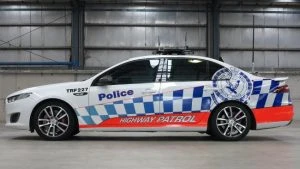 United Kingdom:
United Kingdom:
In spite of the original Top Gear Unholy Trinity sneering that the British police got about mostly in Vauxhall Astras, the modern equivalents of Robert Peel’s special troops get around in a selection of BMWs, mostly 3 and 5 series, plus a few others, including the quirky Renault Twizy (probably as a PR exercise, as this is going to be useless in a high speed chase)
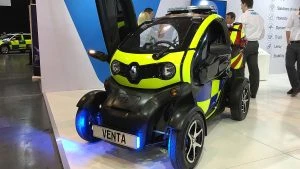
Germany:
What do you think they use as police cars in Germany? Plenty of BMWs (320 Dt being popular), Audi A4s and a smattering of other local marques, including Opels and Volkswagens.
USA:
The most common are the Ford Crown Victoria and the Chevrolet Impala. However, Ford USA also puts out some cop cars that come off the factory floor ready to go on duty, the Ford Police Interceptor Utility being one of them.
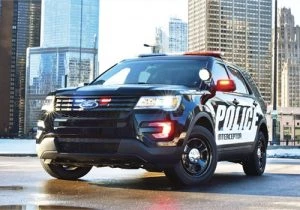
France:
The latest addition to the fleet of the gendarmerie is the Renault Megane Coupé RS . Keeping it local and classy!
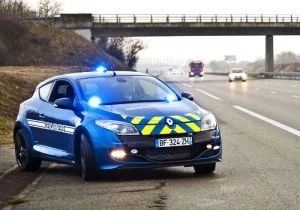
India:
India also believes in keeping things local, which means you’re not going to pick up the equivalent in your local Aussie car yards if you have a hankering to drive what the cops in India drive. At any rate, you’ll have a hard time finding the Mahindra Scorpio and an even harder one finding the Mahindra Marksman (which comes complete with machine gun mounts).

Israel:
Without the need to keep things local and with a need for serious security, the Israeli police – which is considered to be a division of the military Special Forces – need something pretty rugged. Toyota Landcruisers, Isuzu Troopers and Land Rover Defenders all get used, as do Hummers. In urban areas, a selection of sedans get used, with Toyotas being spotted frequently.
Russia:
Wikipedia lists a host of Ladas as being the patrol car of choice for the Russian police. However, before you decide that this is the best place to try a heist, think again. The fleet has recently been updated with a collection of Audi R8 V8s.
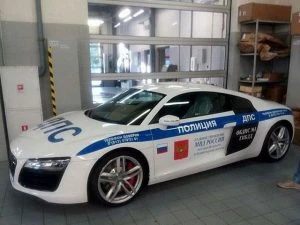
Finland:
In a land where rally driving is one of the top sports and getting a license means some really intensive training including ice driving, what do the cops use? The English version of the official Finnish police site is coy about the marques used but prodding elsewhere suggests that alongside vans of various types, the Mercedes Shooting Brake is part of the fleet. See how you go with one official video – even if you speak no Suomi, you can pick out the words for “police” and “Mercedes Shooting Brake” easily enough.
Incidentally, for those who prefer a second-hand car to a new one, I’ve heard it said that getting an ex-cop car can be a good pick. They have high mileages but have been superbly maintained with speed camera fines taxpayer dollars. All the extra bells and whistles, beginning with the lights and sirens, are removed before sale, though!
2017 Toyota Corolla Ascent Sedan: A Private Fleet Car Review.
Car makers tend to have a vehicle that seems to define what that brand is. Holden has the Commodore and Kingswood, Ford the Falcon, Jaguar the XJ6. For Japanese goliath, Toyota, you can say Land Cruiser and Corolla and it’s the latter that perhaps embodies how a brand can be seen. Private Fleet checks out the heart of Toyota, the 2017 Corolla Ascent, in sedan and CVT form. Apart from the obvious difference in body shape between hatch and sedan, Toyota have given the sedan some subtle but noticeable design tweaks. The bonnet’s shut lines are more aligned with the Camry and the headlight structure is longer, running down towards the centre of the grille further than the hatch’s. Toyota have also given the front a more Camry and Lexus look, with the “spindle” look more noticeable.
Apart from the obvious difference in body shape between hatch and sedan, Toyota have given the sedan some subtle but noticeable design tweaks. The bonnet’s shut lines are more aligned with the Camry and the headlight structure is longer, running down towards the centre of the grille further than the hatch’s. Toyota have also given the front a more Camry and Lexus look, with the “spindle” look more noticeable. The taillights echo the Camry and there’s three distinctive crease lines under the C pillar, plus an aero ridge inside the wing mirrors to deflect rain. It’s the rear that lends a slightly frumpy look to the car, with a curve coming down from the lights and a high set join line, making the rear look heavy. The Ascent has 15 inch steel wheels with an alloy look complete the exterior. It’s also bigger than the styling has you believe, with an overall length of 4620 mm encapsulating a 2700 mm wheelbase and 470L boot, bracketed by a low 1460 mm height and a surprising 1775 mm width.
The taillights echo the Camry and there’s three distinctive crease lines under the C pillar, plus an aero ridge inside the wing mirrors to deflect rain. It’s the rear that lends a slightly frumpy look to the car, with a curve coming down from the lights and a high set join line, making the rear look heavy. The Ascent has 15 inch steel wheels with an alloy look complete the exterior. It’s also bigger than the styling has you believe, with an overall length of 4620 mm encapsulating a 2700 mm wheelbase and 470L boot, bracketed by a low 1460 mm height and a surprising 1775 mm width. Inside it’s typical Corolla and, in parts, doesn’t look like it’s changed since the 1970s. Black solid plastic, rotary dials for aircon and vents contrast with the brilliant blue backlit dials and touchscreen. There’s some brightwork with alloy look plastics on the doors, steering wheel hub, centre console and on the edges of the touchscreen.
Inside it’s typical Corolla and, in parts, doesn’t look like it’s changed since the 1970s. Black solid plastic, rotary dials for aircon and vents contrast with the brilliant blue backlit dials and touchscreen. There’s some brightwork with alloy look plastics on the doors, steering wheel hub, centre console and on the edges of the touchscreen.
 The seats and steering column are manually adjusted, with a basic black cloth covering the pews. Staying true to the history of the Corolla, Toyota fits a non electric, “old style”, lift up hand brake. And there’s never anything less in the presence than the feeling of typical Toyota build quality.
The seats and steering column are manually adjusted, with a basic black cloth covering the pews. Staying true to the history of the Corolla, Toyota fits a non electric, “old style”, lift up hand brake. And there’s never anything less in the presence than the feeling of typical Toyota build quality. Up front is the tried and proven combination of a 1.8L block with a four valve alloy head. Drinking unleaded at a rate of 6.8L/100 km (claimed, combined cycle) from a 55L tank, the engine produces 103 kilowatts at 6400 rpm, and requires 4000 revs to produce a maximum torque of 173 Nm. The test car was fitted with a seven speed CVT, in opposition to the standard six speed manual.
Up front is the tried and proven combination of a 1.8L block with a four valve alloy head. Drinking unleaded at a rate of 6.8L/100 km (claimed, combined cycle) from a 55L tank, the engine produces 103 kilowatts at 6400 rpm, and requires 4000 revs to produce a maximum torque of 173 Nm. The test car was fitted with a seven speed CVT, in opposition to the standard six speed manual.  Toyota have programmed this to act a little more like a traditional auto, in that there’s more feeling of a change of gear and a little less focus on the traditional CVT characteristic, that climb through the rev range and holding at a certain point as speed builds. The variable valve timing’s change is also perceptible, with an extra kick at somewhere around 3500 rpm.
Toyota have programmed this to act a little more like a traditional auto, in that there’s more feeling of a change of gear and a little less focus on the traditional CVT characteristic, that climb through the rev range and holding at a certain point as speed builds. The variable valve timing’s change is also perceptible, with an extra kick at somewhere around 3500 rpm. On the road, the Ascent’s ability to be an average, every day, mode of transport is on display. It’s neither under or overwhelming its ride, handling, comfort level. It just simply…does. Acceleration is neither leisurely nor outstandingly rapid, steering is neither sharp nor excessively vague, with more than a seemingly normal turn left and right to get the car around corners. The skinny-ish 195/65 tyres will provide enough grip for normal driving, but anything remotely sporting has them understeer and squealing in protest. They’ll also tramline, having the Ascent follow ruts and ridges, however the steering is polished enough for drivers to stay in control. However, the brakes are amongst the best in class, with a beautifully weighted feel from top to bottom, and no sense of anything other than the foot being able to read just where in the process the grip level is.
On the road, the Ascent’s ability to be an average, every day, mode of transport is on display. It’s neither under or overwhelming its ride, handling, comfort level. It just simply…does. Acceleration is neither leisurely nor outstandingly rapid, steering is neither sharp nor excessively vague, with more than a seemingly normal turn left and right to get the car around corners. The skinny-ish 195/65 tyres will provide enough grip for normal driving, but anything remotely sporting has them understeer and squealing in protest. They’ll also tramline, having the Ascent follow ruts and ridges, however the steering is polished enough for drivers to stay in control. However, the brakes are amongst the best in class, with a beautifully weighted feel from top to bottom, and no sense of anything other than the foot being able to read just where in the process the grip level is. Although entry level, there’s a rear camera, parking sensors, Bluetooth, a cruise control related distance sensor, apps via the touchscreen (which require a smart phone to be paired), and a range of driver’s information via the dash’s central screen. There’s no DAB, nor do all windows get one touch up/down movement. However there’s still only a three year warranty for car and paint and just five years for corrosion.
Although entry level, there’s a rear camera, parking sensors, Bluetooth, a cruise control related distance sensor, apps via the touchscreen (which require a smart phone to be paired), and a range of driver’s information via the dash’s central screen. There’s no DAB, nor do all windows get one touch up/down movement. However there’s still only a three year warranty for car and paint and just five years for corrosion. At The End Of The Drive.
At The End Of The Drive.
The Corolla Ascent sedan is the embodiment of the reason why the Corolla has been, for so long, the world’s number one selling car. It does what it does, quietly, with an unassuming way about it, without setting the world on fire. And that’s the appeal of the Corolla: there’s no surprises, you know exactly what you’re getting, and it’s dependable and reliable as a sunrise.
For pricing and details, go here:2017 Toyota Corolla Ascent
Lamborghini Huracán Performante Breaks The 'Ring's Lap Record.
The Lamborghini Huracán Performante has already proved its extraordinary capabilities ahead of its unveiling at Geneva Motor Show next week. On 5 October 2016, the Huracán Performante set a new production car lap record of 6:52.01 min on the Nürburgring Nordschleife in Germany.
Following the day’s open sessions on the “Ring”, at 17.00 officials closed the track to other manufacturers. After official track checks this left just a
15-minute window for Lamborghini to make one attempt at the lap record with a production Huracán Performante, still in its development camouflage.
With Lamborghini test driver Marco Mapelli behind the wheel, who also drove the Aventador SV to its Nürburgring sub seven-minute lap time in 2015, the Huracán Performante warmed up its tires and made its rolling start, fitted inside and out with onboard cameras and telemetry to record the car’s lap. The Lamborghini team of R&D engineers, technicians and drivers, together with Stefano Domenicali, Chairman and Chief Executive Officer and Maurizio Reggiani, Board Member for Research & Development, watched the Performante disappear into the distance of the 20.6 km track.
In the sixth minute, the car was heard heading down the long straight with just three corners to go, and its audience counting down the seconds to watch the Huracán Performante pass over the line at 6:52.01 min.
“This was an incredible and emotional moment,” says Stefano Domenicali. “Together with Maurizio Reggiani we agreed during the car’s development that with the technical and performance prowess of the Huracán Performante, not only was a sub seven-minute lap at the Nordschleife possible, but the lap record too. We wanted to achieve the Nürburgring victory in advance of the Performante’s launch, which was a challenge in terms of weather and availability of the Nordschleife. Not only did we take the lap record, we took it by some seconds!
“To make this happen is something that every one of the R&D team who worked on this car can share in: it will forever be a defining moment in their careers,” concludes Stefano Domenicali. “I am so proud of everything achieved by Lamborghini people that day and extremely privileged to have witnessed it.”
The Huracán Performante features innovations in aerodynamics and lightweight engineering that, combined with its improved power plant, its four-wheel drive system, its Lamborghini Piattaforma Inerziale and a dedicated set-up, allows superior track performance to be maximized while delivering the most engaging and dynamic road drive.
Joining the Lamborghini development team at the Nürburgring were representatives from Pirelli, responsible for development of tires specifically for the Huracán Performante: the same Pirelli Trofeo R tires available on cars delivered to owners.
The Huracán Performante is revealed officially by Automobili Lamborghini at Geneva Motor Show on the first press day, 7 March 2017, 8.55 am at the Lamborghini stand. Follow the unveiling in Geneva at live.lamborghini and join the conversation with #HuracanPerformante.
(Republished by Private Fleet on behalf of Lamborghini Australia’s PR compnay, The Origin Agency)
Private Fleet Car Review: 2016 Peugeot 2008 Outdoor Diesel Manual
Peugeot’s 2008 kicks off a month of French chic at A Wheel Thing, with the Citroen Picasso, Peugeot 308 GTi and the 508 sedan pencilled in as well.
The 2008 is a small to mid sized SUV, with a diesel and an unexpected five speed manual. Unexpected in that it was a manual and unexpected in that it was “just” a five speed, not six. It’s here that mentioning it’s a three level range and the manual is the TOP of the range (the other two are the Active and Allure) puts this into a different perspective. Power from the 1.6 litre capacity engine isn’t bad, at 68 kilowatts, but there’s a wealth of torque, with 230 of them at 1750. Redline for the Outdoor starts at 4500 and it feels like that torque runs through to 4000. That’s why the surprise at just five cogs, not six, as there’s enough twist to deal with an appropriately geared extra ratio. Whatever Peugeot’s reason, you can’t fault that the five do a good job on economy. Peugeot quotes a combined figure of 4.0L per 100 kilometres and just 3.6L of the good oil for every 100 klicks out on the highway. Around town, it’s still frugal, sipping 4.6L/100 km. Tank size? 50 litres, so, theoretically, Sydney to Melbourne or Sydney to Brisbane on a tank and then some.
That’s why the surprise at just five cogs, not six, as there’s enough twist to deal with an appropriately geared extra ratio. Whatever Peugeot’s reason, you can’t fault that the five do a good job on economy. Peugeot quotes a combined figure of 4.0L per 100 kilometres and just 3.6L of the good oil for every 100 klicks out on the highway. Around town, it’s still frugal, sipping 4.6L/100 km. Tank size? 50 litres, so, theoretically, Sydney to Melbourne or Sydney to Brisbane on a tank and then some.
It’s also very refined, with barely a chatter under load and almost imperceptible when not. Even when punted hard from standstill, the characteristic noise expected was muted. It’ll pull nicely, with those five ratios well spread and matched with a well balanced clutch & pick up point, offers the driver a joyful experience. But if you’re expecting a rocketship, forget it, as an 11.5 second run to the century is….leisurely, at best. The 2008 Outdoor also rides, as you’d expect, pretty well and handles, as you’d expect, pretty well. There is a notable measure of understeer, as if the steering rack ratio needs some tightening up It’s also slightly numb on centre and never feels as if the turn you do is quite enough to pull the nose around as tight as you expect. As a package it’s liveable with, as it’s firm without being excessively taut, compliant without excessive softness and barrels over the usual speedhumps and bumps with only minimal intrusion, thanks to a torsion bar rear and Macpherson strut front.
The 2008 Outdoor also rides, as you’d expect, pretty well and handles, as you’d expect, pretty well. There is a notable measure of understeer, as if the steering rack ratio needs some tightening up It’s also slightly numb on centre and never feels as if the turn you do is quite enough to pull the nose around as tight as you expect. As a package it’s liveable with, as it’s firm without being excessively taut, compliant without excessive softness and barrels over the usual speedhumps and bumps with only minimal intrusion, thanks to a torsion bar rear and Macpherson strut front. It’s not a terrible place to be either, inside the 2008 Outdoor. It’s a mostly ergonomic dash but the dials placed above the rim of the tiller takes some getting used to.
It’s not a terrible place to be either, inside the 2008 Outdoor. It’s a mostly ergonomic dash but the dials placed above the rim of the tiller takes some getting used to. The overall look is of high quality, easy to use buttons, plus a lack of reflection of the plastic in the windscreen is a pleasant bonus. There’s some silver/chrome trim that does catch the sun and reflect into eyes to deal with however. The dash design itself is a smooth curve, both into the binnacle directly ahead of the driver and to the downwards curve of the centre console housing the touchscreen (housing DAB, satnav and music streaming), centre vents, and aircon controls.
The overall look is of high quality, easy to use buttons, plus a lack of reflection of the plastic in the windscreen is a pleasant bonus. There’s some silver/chrome trim that does catch the sun and reflect into eyes to deal with however. The dash design itself is a smooth curve, both into the binnacle directly ahead of the driver and to the downwards curve of the centre console housing the touchscreen (housing DAB, satnav and music streaming), centre vents, and aircon controls.  You’ll also get a dial to change the drive settings, such as Snow, Mud, and Sand, a system Peugeot calls Grip Control.
You’ll also get a dial to change the drive settings, such as Snow, Mud, and Sand, a system Peugeot calls Grip Control.
The seats were suberb to sit in; a mix of leather (soft, supple, real leather) and cloth for the centre of the squab and backrest meant that a need for heating wasn’t as crucial as a need for ventilation. That appears to be something found across the Peugeot cars tested (more on those separately) and it certainly makes for a comfy office to be in. Having a thick, chunky, feel to the steering wheel didn’t go astray either. There’s also blue LED lighting in the surrounds for the sunroof and for the dash; it looks good, adds class and isn’t distracting. There’s also plenty of room for rear seat passengers and more than enough cargo space for a four member family, ranging from 410 to 1400 litres.
Having a thick, chunky, feel to the steering wheel didn’t go astray either. There’s also blue LED lighting in the surrounds for the sunroof and for the dash; it looks good, adds class and isn’t distracting. There’s also plenty of room for rear seat passengers and more than enough cargo space for a four member family, ranging from 410 to 1400 litres.
 Outside, the 2008 is a svelte looking beastie. Sitting in a size range above the 4008 (which is based on the Mitsubishi ASX platform) it looks more compact that the interior space would have you believe. It’s just 4159 mm long, would you believe, but manages to cram in a 2537 mm wheelbase, meaning there is plenty of interior space.
Outside, the 2008 is a svelte looking beastie. Sitting in a size range above the 4008 (which is based on the Mitsubishi ASX platform) it looks more compact that the interior space would have you believe. It’s just 4159 mm long, would you believe, but manages to cram in a 2537 mm wheelbase, meaning there is plenty of interior space.  It’s curvy, with few hard edges, but does sport shark fin line design features into the headlights and a similar motif into the rear. A steeply rising window line follows the crease from the front wheel arch through to the tail lights, providing a definitive visual balance to a good looking profile. Rubber is Goodyear 205/50/17 and they’re some good looking alloys, just quietly.
It’s curvy, with few hard edges, but does sport shark fin line design features into the headlights and a similar motif into the rear. A steeply rising window line follows the crease from the front wheel arch through to the tail lights, providing a definitive visual balance to a good looking profile. Rubber is Goodyear 205/50/17 and they’re some good looking alloys, just quietly. You’re covered when it comes to safety, with front, side and curtain airbags, the usual suite of electronic driver assistance aids, cornering front lamps and Hill Assist, which locks the brakes momentarily when you’re on a slope and the engine’s running. In regards to the body, Peugeot offers a 12 year anti perforation corrosion warranty, 24 hour road side assist, capped price servicing and that’s every 12 months or 15000 kilometres. Warranty? Three years or 100000 kilometres.
You’re covered when it comes to safety, with front, side and curtain airbags, the usual suite of electronic driver assistance aids, cornering front lamps and Hill Assist, which locks the brakes momentarily when you’re on a slope and the engine’s running. In regards to the body, Peugeot offers a 12 year anti perforation corrosion warranty, 24 hour road side assist, capped price servicing and that’s every 12 months or 15000 kilometres. Warranty? Three years or 100000 kilometres.
At The End Of The Drive.
At the time of writing (November, 2016) Peugeot Australia was offering the 2008 Outdoor at a wonderful driveaway price of $30990, a savings of $6000 from the normal driveaway of $37K. Given Australia’s seeming obsession with SUVs, this is one that slides under the radar yet deserves a better look. Head to Peugeot Australia for more information.